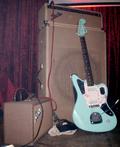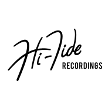I haven't seen these three BBC documentaries entitled "Guitar, drums and bass" but according to my buddy "Episode 2 - Bass with Tina Weymouth" there is an interview with Paul McCartney. I'm guessing this would have been Beatles Abbey Road point of time - He said he wasn't happy with recorded sound of his bass guitar and an engineer came up with the idea of using a speaker instead of a microphone and reversing the polarity. I'm not entirely sure how it was done but it entails the amp speaker cone in opposite back/forth movement to the speaker-microphone.
dp:
dude
358 days ago
Bango_Rilla:
Shout Bananas!!
313 days ago
BillyBlastOff:
See you kiddies at the Convention!
297 days ago
GDW:
showman
248 days ago
Emilien03:
https://losg...
170 days ago
Pyronauts:
Happy Tanks-Kicking!!!
164 days ago
glennmagi:
CLAM SHACK guitar
149 days ago
Hothorseraddish:
surf music is amazing
129 days ago
dp:
get reverberated!
80 days ago
Clint:
“A Day at the Beach” podcast #237 is TWO HOURS of NEW surf music releases. https://link...
13 days ago
No polls at this time. Check out our past polls.
No contests at this time. Check out our past contests.
- 1st – betomunhoz, Coach, lsylte
- 2nd – BorfJr, GatoStrato, InstroChick, NoiseFloor, Tikitena, ZombieGroove
- 3rd – bobdeans, Dohenyjoe, FredJr, fulgore, Joheny, Masuto
- 4th – Freehawk, JoeJazz2000, PhantomOperators
- 5th – DJ_Sid_Presley, JBPhoto, Millwinder, verschuurpual
- 6th – stimey
- 7th – Agent_Z, BoB69, yantiliu
- 8th – GandyDancer, ruglandma, surfbeat99
- 9th – BradMcNulty, Jerry13
- 10th – Pastana75, tonymcgowan55, tvardy
- 11th – spskins, TheeAaronRev, Wellens_
- 12th – GulfofBrass, PistonDude, SmileySmile, SoCalOldGuy1956, SpaceTimC, Thunderbird
- 13th – Amplion, Beeza71, TheOutpost
- 14th – gabrielpowell, Rskingdom
- 15th – Agent_15, mikeo, speedfaias
- 16th – d4man, dustyWyo, instrumentwire, LM_Olympic, Marky_Wildstone, Rome, SwampCat
- 17th – bigkahunaron, electronificated, jdangerously57, Jimmy_Strings, mom_surfing
- 18th – acidjoker, JohnBlutarski, pavlovsdog
- 19th – Andolf, balt11tab, JoeKer_Z_Wilde, mschafft, ShortScalePDX
- 20th – juankamilo0surf, Skullie
- 21st – Hothorseraddish
- 22nd – BeachCombers, Londonbus, RandySG88, surfdefender2013, SurfsUp, sworgs
- 23rd – 3singes, bubbaznetti, Pingrider, StingrayStingray
- 24th – bigaaron, thesidss
- 25th – romainsan, Rudy92
- 26th – elreydlp, eocb, IvanP, Pyronauts, Trafolta, vampireautoparts
- 27th – coffin_wheels, cohen2344, Donald77, easydranch, Finkdaddy, nsiegel27, Todd_Kelp
- 28th – aaronBONESbata, Silverface
- 29th – DNAdude, rickylasvegas
- 30th – Bennie01, blueeyedlava
- 31st – Hodaddy, Ludella, RedBeard

SurfGuitar101 Forums » Recording Corner »
 recording with a loudspeaker instead of a microphone
recording with a loudspeaker instead of a microphone
|
Joined: Sep 09, 2008 Posts: 3158 Guildford England 




|
|
|
Joined: Dec 08, 2007 Posts: 1305 

|
crumble wrote:
It was done for "Paperback Writter". The Beatles weren't satisfied with the low end on their records, and wanted the bass sound they heard on Motown records. Geoff Emerick realized that a speaker is just basically a reverse wired microphone, and used a bass cab for a mic.
https://www.facebook.com/coffindagger Last edited: Jan 25, 2019 08:05:46 |
|
Joined: May 04, 2014 Posts: 734 


|
- Last edited: Mar 08, 2022 13:09:21 |
|
Joined: Apr 03, 2010 Posts: 3201 Jacksonville, AL 





|
We used a makeshift version of this on the kick drum in one of our recording sessions. It is not uncommon these days. Of course, it was not the only mic on the kick. —THE KBK ... This is the last known signal. We offer Sanctuary. www.thekbk.com |
|
Joined: Jun 14, 2006 Posts: 521 NYC 




|
This is from this past weekend at the studio where we are recording our next CD.
TarantinosNYC Last edited: Feb 13, 2019 19:08:04 |
|
Joined: Aug 23, 2006 Posts: 2123 The jungle 








|
Any speaker is a pretty fair microphone. (Well, except piezoelectric ones.) Classical LPs were recorded with speakers in the early days, or so the liner notes told me. — |
|
Joined: Jan 02, 2009 Posts: 1307 The original Plymouth, UK. 





|
I would imagine that in Abbey Road days, the speaker would have been an alnico one, and would offer some degree of compression compared to a microphone. I'd say that using a compressor on the bass guitar would achieve a similar effect of amplifying harmonics and thickening the sound. — |
|
Joined: Jul 30, 2016 Posts: 896 
|
Coupled with singing leads through your headphones and the harmonies through a Teisco guitar's pickups, you've got quite a memorable sound! |
|
Joined: Jun 06, 2020 Posts: 13 
|
I've mixed a few productions where a Yamaha Sub-Kick was used to record the bass drum, but always in conjunction with other microphones. The idea of the Sub-kick (or any speaker woofer used as a microphone) is to capture the very lowest frequencies that the bass drum produces. A speaker-woofer shares the same basic elements as a dynamic microphone: A diaphragm with a copper coil attached to it, sitting in the field of a magnet. But a speaker is designed to produce low-frequency sound, sometimes at high volumes, so it has a relatively large, heavy diaghragm/coil assembly. Making the heavier, stiffer assembly vibrate to produce sound is no problem because it will be powered by a powerful amplifier of some sort. It sounds great in conjunction with a microphone, especially if you're using a microphone that can't respond well to low frequencies, but the signal that comes from contains only the very lowest frequencies so you'd miss out on all the "attack" of the bass drum if you used it on its own. |


 >
> 




















